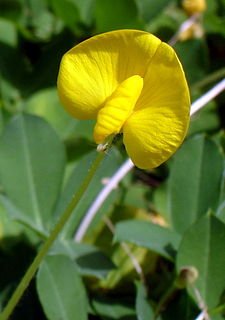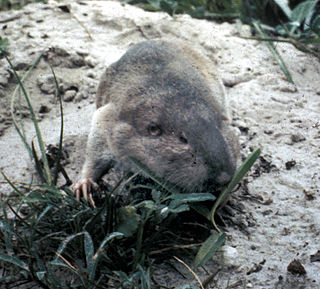
Paspalum is a genus of plants in the grass family.

The Tehuantepec jackrabbit is a jackrabbit endemic to Mexico.

Axonopus compressus is a species of grass. It is often used as a permanent pasture, groundcover, and turf in moist, low fertility soils, particularly in shaded situations. It is generally too low-growing to be useful in cut-and-carry systems or for fodder conservation.

Arachis glabrata is a high-quality forage plant native to Argentina, Brazil, and Paraguay vegetation. This plant is also used for soil conservation and as an ornamental plant.

The chestnut-breasted mannikin, also known as the chestnut-breasted munia or bully bird, is a small brown-backed munia with a black face and greyish crown and nape. It has a broad ferruginous breast bar above a white belly. The species is found in Australia, New Caledonia, Indonesia, and Papua New Guinea. This species has also been introduced to French Polynesia and France.
Paspalum azuayense is a species of grass in the family Poaceae. It is found only in Ecuador.
Paspalum rugulosum is a species of grass in the family Poaceae. It is found only in Ecuador.

The Texas pocket gopher is a species of rodent in the family Geomyidae. It is found in Tamaulipas in Mexico and in Texas in the United States.

Omiodes continuatalis is a species of moth in the family Crambidae. It is endemic to the Hawaiian islands of Kauai, Oahu, Molokai, Maui, Lanai and Hawaii. It was first cited as possibly extinct by W.C. Gagné and Francis Gard Howarth in 1982. It was listed as extinct by the Hawaiʻi Biological Survey in 2002 and the IUCN in 2003, but was rediscovered later in 2003.

Helicia is a genus of 110 species of trees and shrubs, constituting part of the plant family Proteaceae. They grow naturally in rainforests throughout tropical South and Southeast Asia, including India, Sri Lanka, Indochina, Peninsular Malaysia to New Guinea and as far south as New South Wales.

Paspalum dilatatum is a species of grass known by the common name dallisgrass, Dallas grass, or sticky heads. It is native to Brazil and Argentina, but it is known throughout the world as an introduced species and at times a common weed. Its rapid growth and spreading rhizomes make it an invasive pest in some areas. It is present in the southern half of North America, southern Europe, much of Africa, Australia, New Zealand, and many tropical and subtropical areas.
Paspalum distichum is a species of grass. Common names include knotgrass, water finger-grass, couch paspalum, eternity grass, gingergrass, and Thompson grass. Its native range is obscure because it has long been present on most continents, and in most areas it is certainly an introduced species. Its native range probably includes parts of the tropical Americas.

Paspalum urvillei is a species of grass known by the common name Vasey's grass, or Vaseygrass. It is native to South America, and it is known in parts of North America as an introduced species. It is also naturalised in Australia, New Zealand, Japan, China, and southern Africa, including Madagascar. It is a noxious weed where it has been introduced in Hawaii and New Caledonia. It grows well in disturbed habitat, often in moist areas. This is a rhizomatous perennial grass which may reach 2 meters tall. The leaves are up to 2.5 centimeters wide and have a large, noticeable ligule. The inflorescence is a spreading or drooping array of up to 20 branches lined with rounded spikelets.
Euphorbia deppeana is a rare species of flowering plant in the family Euphorbiaceae known by the common names Deppe's broomspurge and Oahu sandmat. It is endemic to Oʻahu, Hawaii, where it is known from only one population in moist shrublands on Nuʻuanu Pali. Like other native Hawaiian euphorbs it is called ʻakoko locally.
Clermontia samuelii is a rare species of flowering plant in the bellflower family known by the common name Hana clermontia. It is one of several Hawaiian lobelioids in genus Clermontia that are known as `oha wai. This plant is endemic to Maui, where there are fewer than 250 mature specimens remaining. This is a federally listed endangered species of the United States.
Paspalum repens, known as horsetail paspalum or water paspalum, is a species of grass native to South America, Central America, and North America. It is often called Paspalum fluitans, though this name is treated as a synonym of P. repens in Kew's Plants of the World Online database and the Flora of North America project.

Paspalum setaceum is a species of grass known by several common names, including thin paspalum. It is native to the Americas, where it can be found in the eastern and central United States, Ontario in Canada, Mexico, Central America, and the Caribbean. It can be found in other areas of the world as an introduced, and often invasive, species, including many Pacific Islands. It is a weed of lawns and turf.

Paspalum vaginatum is a species of grass known by many names, including seashore paspalum, biscuit grass, saltwater couch, silt grass, and swamp couch. It is native to the Americas, where it grows in tropical and subtropical regions. It is found throughout the other tropical areas of the world, where it is an introduced species and sometimes an invasive weed. It is also cultivated as a turfgrass in many places.












